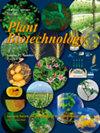铜处理桃叶会导致类似于生物应激反应的损伤形成。
IF 1.4
4区 生物学
Q4 BIOTECHNOLOGY & APPLIED MICROBIOLOGY
引用次数: 2
摘要
桃(Prunus persica(L.)Batsch)叶片对铜(Cu)暴露敏感。铜暴露的症状与细菌性斑点病的症状相似;然而,铜暴露引起病变形成的机制尚不清楚。在这里,我们研究了铜暴露引起的损伤形成是否与植物对微生物病原体的抗性机制有关。当铜被施加到桃叶针孔的中心时,观察到一个两步过程。一个浅绿色的甜甜圈形状的部分,位于远离Cu处理点的地方,首先出现在用2 mM CuSO4。接下来,黄白色部分从Cu处理点逐渐扩展到浅绿色部分。最后,在浅绿色部分的中间形成了一个缺口。浅绿色部分的内部包含96%的Cu,表明Cu保留在病变区域中。对编码致病相关蛋白和参与植物抗毒素合成的酶的基因表达的实时PCR分析显示,在8个测试的基因中,有3个基因(编码几丁质酶、致病相关蛋白4和β-1,3-葡聚糖酶-3)被Cu处理上调。此外,胱天蛋白酶-1抑制剂的治疗减少了病变的形成。这些结果表明,Cu处理桃叶会导致细胞死亡,类似于生物胁迫反应期间发生的死亡。本文章由计算机程序翻译,如有差异,请以英文原文为准。
Copper treatment of peach leaves causes lesion formation similar to the biotic stress response.
Peach (Prunus persica (L.) Batsch) leaves are sensitive to copper (Cu) exposure. The symptoms of Cu exposure are similar to those of bacterial spot disease; however, the mechanism underlying lesion formation caused by Cu exposure is not clear. Here, we investigated whether lesion formation caused by Cu exposure was related to the mechanism underlying plant resistance to microbial pathogens. When Cu was applied to the centre of a pinhole on peach leaves, a two-step process was observed. A pale green section in the shape of a doughnut, located far from a Cu treatment point, first appeared on a leaf treated with 2 mM CuSO4. Next, a yellow-white section gradually spread from the Cu treatment point to the pale green section. Finally, a gap was formed in the middle of the pale green section. The inner part of the pale green section contained 96% of the Cu applied, indicating that Cu is retained in the lesion area. Real-time PCR analysis of the expression of genes encoding pathogenesis-related proteins and enzymes involved in phytoalexin synthesis revealed that three genes (encoding chitinase, pathogenesis-related protein 4, and β-1,3-glucanase-3) of the eight tested were upregulated by Cu treatment. Furthermore, treatment with caspase-1 inhibitors reduced lesion formation. These results show that Cu treatment of peach leaves causes cell death similar to that occurring during the biotic stress response.
求助全文
通过发布文献求助,成功后即可免费获取论文全文。
去求助
来源期刊

Plant Biotechnology
BIOTECHNOLOGY & APPLIED MICROBIOLOGY-PLANT SCIENCES
CiteScore
2.90
自引率
18.80%
发文量
45
审稿时长
6-12 weeks
期刊介绍:
Plant Biotechnology is an international, open-access, and online journal, published every three months by the Japanese Society for Plant Biotechnology. The journal, first published in 1984 as the predecessor journal, “Plant Tissue Culture Letters” and became its present form in 1997 when the society name was renamed to Japanese Society for Plant Cell and Molecular Biology, publishes findings in the areas from basic- to application research of plant biotechnology. The aim of Plant Biotechnology is to publish original and high-impact papers, in the most rapid turnaround time for reviewing, on the plant biotechnology including tissue culture, production of specialized metabolites, transgenic technology, and genome editing technology, and also on the related research fields including molecular biology, cell biology, genetics, plant breeding, plant physiology and biochemistry, metabolic engineering, synthetic biology, and bioinformatics.
 求助内容:
求助内容: 应助结果提醒方式:
应助结果提醒方式:


